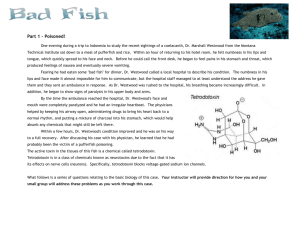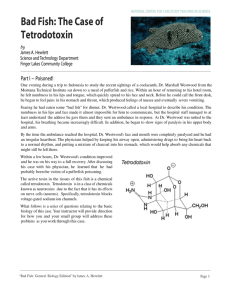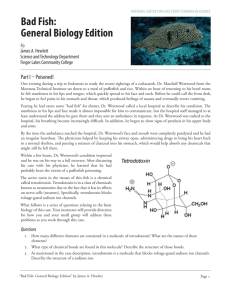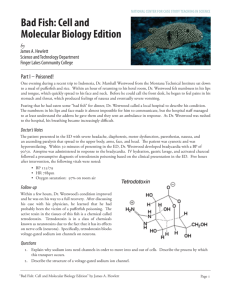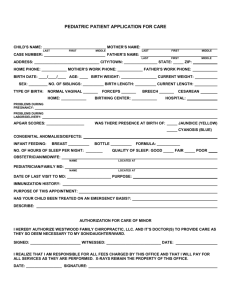Bad Fish - National Center for Case Study Teaching in Science
advertisement
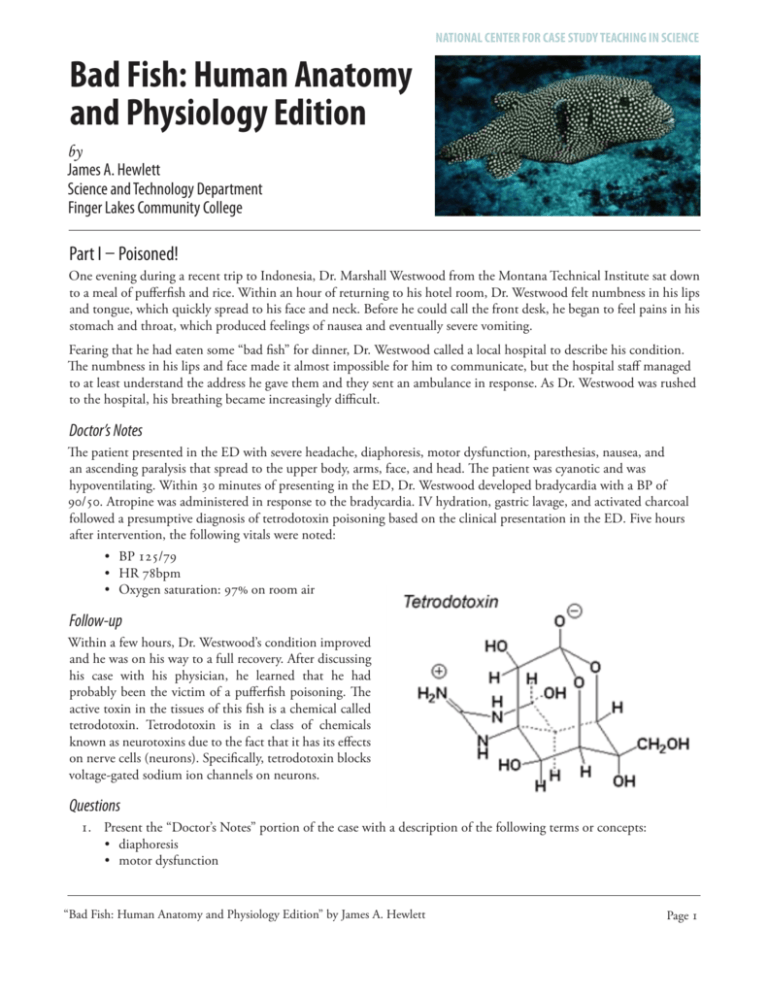
NATIONAL CENTER FOR CASE STUDY TEACHING IN SCIENCE Bad Fish: Human Anatomy and Physiology Edition by James A. Hewlett Science and Technology Department Finger Lakes Community College Part I – Poisoned! One evening during a recent trip to Indonesia, Dr. Marshall Westwood from the Montana Technical Institute sat down to a meal of pufferfish and rice. Within an hour of returning to his hotel room, Dr. Westwood felt numbness in his lips and tongue, which quickly spread to his face and neck. Before he could call the front desk, he began to feel pains in his stomach and throat, which produced feelings of nausea and eventually severe vomiting. Fearing that he had eaten some “bad fish” for dinner, Dr. Westwood called a local hospital to describe his condition. The numbness in his lips and face made it almost impossible for him to communicate, but the hospital staff managed to at least understand the address he gave them and they sent an ambulance in response. As Dr. Westwood was rushed to the hospital, his breathing became increasingly difficult. Doctor’s Notes The patient presented in the ED with severe headache, diaphoresis, motor dysfunction, paresthesias, nausea, and an ascending paralysis that spread to the upper body, arms, face, and head. The patient was cyanotic and was hypoventilating. Within 30 minutes of presenting in the ED, Dr. Westwood developed bradycardia with a BP of 90/50. Atropine was administered in response to the bradycardia. IV hydration, gastric lavage, and activated charcoal followed a presumptive diagnosis of tetrodotoxin poisoning based on the clinical presentation in the ED. Five hours after intervention, the following vitals were noted: • BP 125/79 • HR 78bpm • Oxygen saturation: 97% on room air Follow-up Within a few hours, Dr. Westwood’s condition improved and he was on his way to a full recovery. After discussing his case with his physician, he learned that he had probably been the victim of a pufferfish poisoning. The active toxin in the tissues of this fish is a chemical called tetrodotoxin. Tetrodotoxin is in a class of chemicals known as neurotoxins due to the fact that it has its effects on nerve cells (neurons). Specifically, tetrodotoxin blocks voltage-gated sodium ion channels on neurons. Questions 1. Present the “Doctor’s Notes” portion of the case with a description of the following terms or concepts: • diaphoresis • motor dysfunction “Bad Fish: Human Anatomy and Physiology Edition” by James A. Hewlett Page 1 NATIONAL CENTER FOR CASE STUDY TEACHING IN SCIENCE 2. 3. 4. 5. 6. 7. 8. 9. 10. 11. 12. 13. 14. 15. 16. • paresthesias • cyanotic • hypoventilating • bradycardia • gastric lavage • oxygen saturation How many different elements are contained in a molecule of tetrodotoxin? What are the names of these elements? What type of chemical bonds are found in this molecule? Describe the structure of those bonds. As mentioned in the case description, tetrodotoxin is a molecule that blocks voltage-gated sodium ion channels. Describe the structure of a sodium ion. What is a voltage-gated sodium ion channel? What is it made of? What is its function? Why do sodium ions need channels in order to move into and out of cells? Describe the process involved in the movement of ions through these channels. When nerve cells are at rest, there is an unequal amount of positive and negative charges on either side of a nerve cell membrane. This charge difference is called an electrical potential. Describe this “potential” when the neuron is at rest (resting potential). What is happening to the electrical potential of a neuron when it generates an action potential? What is the function of the action potential in neurons? Describe the role of sodium ions and sodium channels in the action potential. What would happen to a neuron if it were exposed to tetrodotoxin? Be specific regarding its effect on the ability of a neuron to communicate. Now that you have addressed some of the basic biology of this case, explain why Dr. Westwood experienced numbness after eating the pufferfish meal. Paralysis is a term used to describe the loss of function of muscle. If tetrodotoxin’s effect is on neurons, why did Dr. Westwood experience paralysis? Explain how tetrodotoxin is involved in the development of hypotension and hypoventilation. Briefly describe the role of the autonomic nervous system in human physiology. What are the two divisions of this system? Atropine was administered in the ED as part of Dr. Westwood’s care. What effect did it have on his vitals after it was administered? Atropine acts as an antagonist within the central nervous system, which means it acts as a blocker of specific cellular functions. What part of the autonomic nervous system does atropine block to produce its effect on Dr. Westwood? “Bad Fish: Human Anatomy and Physiology Edition” by James A. Hewlett Page 2 NATIONAL CENTER FOR CASE STUDY TEACHING IN SCIENCE Part II – Oh No! Not Again After recovering from his TTX poisoning, Dr. Marshall Westwood decided to take a vacation. An avid birder, he decided to go to Papua New Guinea with Bill Whitlatch, an ornithologist friend of his from Montana Technical Institute. Three days into their trip, Bill netted bird with an orange body and black wings and head for closer study. Dr Westwood was very curious and asked Bill if he could have a closer look at the bird. After handling the bird and then later wiping his mouth with his hand, Dr. Westwood noticed that his fingers and lips were going numb. His mind immediately flashed back to the disastrous trip to Indonesia and he began to panic. Luckily, the symptoms faded before they progressed into anything more serious. His friend Bill used a key to identify the animal as a pitohui. The pitohui are small, social songbirds that live in Papua New Guinea. They are generally about 23 centimeters long with strong legs and a powerful beak. Their encounter was the first time anyone had scientifically realized the birds’ toxicity. Before releasing the bird, Dr. Westwood collected feather and tissue samples to bring back to the lab. After returning to Montana, he set out to isolate the toxic compound that he believed was being produced by the pitohui. It appeared that the active ingredient was a homobatrachotoxin. Homobatrachotoxin is a steroidal alkaloid that is similar to batrachotoxin, the toxic principle of the Central American poison arrow frog Phyllobates aurotaenia. Batrachotoxin and homobatrachotoxin are both known to act on the voltage-sensitive sodium channels in excitable tissues. You and your colleagues received a call from Dr. Westwood asking if you could help elucidate the mechanism of action of this toxic compound. One of the hypotheses is that this toxin acts similarly to TTX. Questions 17. In your first experiment, you generated action potentials in axons of large neurons obtained from squid in the presence of this new toxin. You found that after depolarizing, the membrane potential remained positive for an extended length of time, and the repolarization was often extremely delayed. Draw a graph (membrane potential in mV vs. time) to illustrate this effect. 18. As you continued to experiment with higher concentrations of the toxin, you found cases when the cell could not repolarize at all, or if it began to repolarize, it would immediately depolarize again. Using this description and the description in the previous question, describe how this toxin acts on voltage-gated sodium ion channels. “Bad Fish: Human Anatomy and Physiology Edition” by James A. Hewlett Page 3 NATIONAL CENTER FOR CASE STUDY TEACHING IN SCIENCE Part III – Pharmacology In this section, you (or your group) will become a small pharmaceutical company that is trying to develop a drug that can be used in the ED to treat tetrodotoxin poisoning. There is no antidote to tetrodotoxin poisoning. Therefore, it is extremely important that your company is successful in this endeavor. In your report, you need to include the following: • Your Company Name: o What do you want to call your company? Be creative! • Name of Your Drug: • Treatment of: o What does your drug treat? o What other diseases, problems etc. might it be useful for? • Mechanism of Action: o Describe how your drug will work. o Be sure to provide details regarding its action. You are now familiar with the activity of this toxin at the level of molecules and cells, so your description should contain details of how your drug works at that level. • Dosage Form: o How will it be administered to patients? • Side Effects: o What type of side effects might your drug have? Some of your information will come from your understanding of what tetrodotoxin does to neurons. There is no right or wrong answer to how your drug will work because there currently is no drug to treat this problem. After you decide how your drug might work, you should consider if its mechanism would lead to side effects. In addition, your drug may be useful for other problems related to nerve function. You may want to do some research on drugs that have actions at neurons (specifically sodium ion channels) and diseases that involve sodium ion channels. This will help you develop your drug. • Image credits: Photograph on page 1, Arothron meleagris, © John E. Randall. Used with permission. Photograph on page 3, Hooded Pitohui, Jack Dumbacher. Courtesy of the Smithsonian National Museum of Natural History. Case copyright held by the National Center for Case Study Teaching in Science, University at Buffalo, State University of New York. Originally published April 13, 2003. Please see our usage guidelines, which outline our policy concerning permissible reproduction of this work. “Bad Fish: Human Anatomy and Physiology Edition” by James A. Hewlett Page 4
